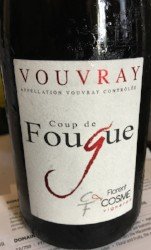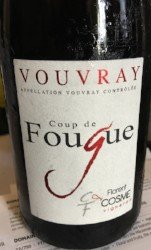
FLORENT COSME | Vouvray Sec “Coup de Fougue” 2016
(Vouvray, Loire Valley, FR) $25
 Great Vouvray sec (dry Vouvray) can taste more like crisp apples than apples do. And this wine from Florent Cosme is a perfect example. Sleek, snappy, and absolutely loaded with minerals, it’s as precise as a dagger. If you’re an “acid freak,” this one’s for you. The wine comes from 40-year-old vines growing in flint and clay over limestone…the legendary soil matrix of the Loire. The Loire Valley is known as the Garden of France, and this Vouvray with a composed salad is to die for. (13% abv)
Great Vouvray sec (dry Vouvray) can taste more like crisp apples than apples do. And this wine from Florent Cosme is a perfect example. Sleek, snappy, and absolutely loaded with minerals, it’s as precise as a dagger. If you’re an “acid freak,” this one’s for you. The wine comes from 40-year-old vines growing in flint and clay over limestone…the legendary soil matrix of the Loire. The Loire Valley is known as the Garden of France, and this Vouvray with a composed salad is to die for. (13% abv)
90 points KM
Available at 56 Degree Wine

Great French Sancerre, made from sauvignon blanc in France’s Loire Valley, has a racy minerality, making it very different from most sauvignon blancs made elsewhere around the world. What gets credit for that prized flintiness?
A. Le Mistral—a bracing spring wind that also dries out the air
B. Terres Blanches—white soils that combine chalk, limestone and clay
C. Sur Lie Aging—leaving the wine for a long time in contact with yeasts
D. Terra Rossa—a soil that combines sandstone and limestone with oxidized iron deposits


Fifty Feet and a Gazillion Seeds
Lodi, the self-proclaimed Zinfandel Capital of the World (it produces over 32 percent of California zin), is also home to 100 different grape varieties, more than any other California region. These include: albariño, tempranillo, verdelho, sangiovese and carignan, as well as more ubiquitous varieties like cabernet. The region began to evolve as a wine region in the early 1900s. Before that, Lodi had been dubbed the Watermelon Capital of the World, boasting melons that were said to be up to 50 feet long. (Hmmmm). Today, Lodi includes some 90 wineries and almost 800 growers farming 100,000+ acres of grapes. The region, about 90 miles east of San Francisco, has become a hotbed for young winemakers priced out of more expensive land elsewhere. Lodi also possesses some of the oldest plant material in the state. Numerous vineyards were planted in the 19th century.
![]()

“I guess I am a chauvinist, but the idea that fine California wine has to be dependent on oak from Europe, as part of its quality, was not acceptable.”
—Paul Draper, CEO, Ridge Vineyards, quoted in Wine Business Monthly, April 2018, referring to his use of American oak to age Ridge wines.
![]()
“Karen, washing my wine glasses the other day, I got to wondering…what exactly is glass?”
—Sheryl W., Menlo Park, CA
Sheryl, simply put, glass is melted sand. Potash (a potassium compound) and bicarbonate of soda are added to make the sand melt at a lower temperature. Today, as in older days, this is done in enormous furnaces, many of which are still in Europe’s Bavarian forest. Lime must also be added to the mixture; otherwise, the glass would eventually dissolve. Lime also increases the durability of glass. In fact, modern dishwashers are so hot that were it not for lime in the glass mixture, your wine glasses would melt.
Have a wine question for me? Send your question to [email protected]
![]()
Trockenbeerenauslese
Trockenbeerenauslese (TRAWK-en-bear-en-OWSS-lay-zeh) wines, or TBAs, are generally made only a few times a decade, and…Keep reading…

Pinot noir takes its name from pine cones.
Answer: True. The highly regarded French grape pinot noir (black pinot) takes its name from pin or pine, a reference to the fact that the small clusters of pinot noir grapes are shaped like pine cones.








